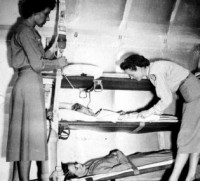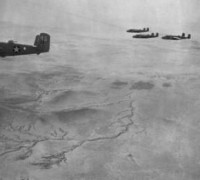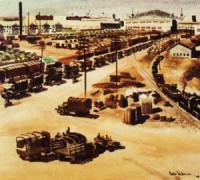WAR IS OVER - THE HOMEWARD BOUND TRAFFIC - AIR EVACUATION
4)HOMEWARD BOUND TRANSPORT
Throughout all its career, down to the eve of victory in 1945, the Air Transport Command was principally preoccupied with the outbound movement of aircraft, men, and materiel from the United States to overseas theaters or to points where aircraft and materiel could be transferred to friendly powers. That there should be some homeward-bound traffic, however, was inevitable.
Mail proceeded in both directions; ferrying pilots, in the system early adopted by the Ferrying Command, had to be returned to their home bases; scarce materials of strategic value in the war effort were flown to American ports on ATC transports; thousands of sick and wounded soldiers flew homeward on ATC planes equipped for air evacuation; and aircraft no longer needed in the theaters were ferried back home. After V-E Day under ATC direction vast numbers of planes and men flew home for redeployment to the Pacific or separation from service.
As early as 1942, pilots of the Ferrying Division after delivering new aircraft to destinations overseas were on occasion directed to ferry war-weary aircraft back to the United States. Thus in November 1942, several ferry pilots who had delivered new P-40's to the Eleventh Air Force at Elmendorf Field, Anchorage, Alaska, were ordered to return old P-36's and P-38's to the United States. The loss of one P-36 from a mechanical failure, and the narrow escape of its pilot, gives some indication of why more of such planes were not returned.
Overseas air bases were reluctant to expend on discarded aircraft the amount of maintenance required for a safe trip home. Ferrying crews, on the other hand, were even more unwilling to fly back a plane in a questionable state of repair. Only a small fraction of the planes which had gone out to the theaters were ever returned in this fashion.
During the twelve-month period extending from 1 April 1944 until 31 March 1945, some 842 military aircraft were ferried back to the United States, as against 22,144 delivered overseas. Throughout 1942 and the early part of 1943, with enemy submarine action continuing to take a large toll of waterborne shipments, air transportation of a minimum of strategic materials was essential to certain aspects of war production.
The Board of Economic Warfare on behalf of the War Production Board, which decided on needs, procured and stocked backlogs of such essential materials at airports on the ATC routes. Such materials included high-quality block mica from Karachi and South America and quartz crystals from South America (both products indispensable in the manufacture of radio parts and equipment). Tantalite, used in producing radio and radar apparatus, and special alloy steels required for cutting tools were flown from Brazil and the Belgian Congo.
Beryl, which in the form of an alloy was used in manufacturing a variety of delicate instruments, came also from Brazil, while rotenone-bearing roots and powder for use in insecticides were brought from various parts of South America. For a time in 1942 rubber was carried when other inbound cargoes were not available. During the twenty-week period between 6 December 1942 and 24 April 1943, the Naval Air Transport Service, ATC, and the contract carriers working under their direction together flew from the east coast of South America to the United States a total of 970.9 tons of such strategic materials.
In the first quarter of 1943 ATC aircraft also lifted some 985 tons of strategic cargo from China to India, while Chinese National Aviation Corporation planes brought out 1,038 tons. The largest elements in this tonnage were tungsten, tin, silk, hog bristles, and mercury. The need for these commodities from China was not usually great enough, however, to justify their shipment west of India by air.
Transcribed and formatted by David Newton for the Hyper War Foundation.


